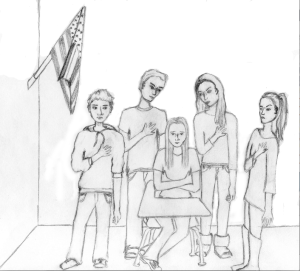 It is 7:40 a.m. and I am surrounded by robots. Hands over their hearts, they automatically recite a Pledge of
It is 7:40 a.m. and I am surrounded by robots. Hands over their hearts, they automatically recite a Pledge of
Allegiance that was ingrained in their heads before they could even read. It doesn’t seem as if any of them are proclaiming their intense, patriotic love for the United States with more than a passing thought.
Even some of those who don’t want to recite the Pledge of Allegiance eventually end up standing uncomfortably. They recite the Pledge of Allegiance with no more than a mumble, staring emptily at the dull, pale white wall next to the flag.

Meanwhile, I am sitting in the middle of this mess wondering why the state of Illinois requires the Pledge of Allegiance to be said every morning in public schools. This tradition started in 1892 when the Pledge of Allegiance was first written, and citizens saluted with their right hands swiftly aiming at a diagonal toward the flag. During World War II, Adolf Hitler used the same gesture. According to CNN, America eventually changed its symbol of allegiance to a hand over one’s heart after the country decided not be associated with Hitler.
I certainly see a connection stemming from our history.
I am not saying that the Pledge of Allegiance is a fascist salute. I am saying, however, that perhaps the Pledge of Allegiance’s bizarre past illustrates that students shouldn’t be as pressured or obligated to say the Pledge of Allegiance as they currently are. It shows our community should reach out toward choice, leaving nationalistic requirements behind.
Students do not have to stand up for the Pledge of Allegiance. Instead, the state law solely requires public primary and secondary schools to allot time every morning for recitation. Although we do have the option, we were taught from a young age that we had to stand up and proudly pledge. Often times, peer pressure to conform inhibits resistance.
I learned this during early second semester when I decided not to stand up to recite the Pledge of Allegiance. I was constantly questioning whether I wanted to say the Pledge of Allegiance, and I wanted to act on my thoughts. My teacher responded by staring at me with confusion, then awkwardly glancing away. A couple of my classmates did just the same, like I was somehow smashing the United States to the ground and feverishly ripping apart the flag. Only from all the stares did I slowly rise and reluctantly place my hand over my heart.
I felt forced.
America should not be free of national symbols, but rather, individuals should be free to express their love for the country with whatever icons and methods they want. I am not against the Pledge of Allegiance. I am in favor of making our own decisions, solely because we are privileged to live under a representative republic, a democracy. The Pledge of Allegiance may be a beautiful display of patriotism, but in no means should it be influenced on the youth of our country in a daily recitation of nationalist jargon.
Sure, if people want to recite the Pledge of Allegiance, then recite the Pledge of Allegiance. If they don’t, then don’t.
Our community needs to realize that even if the Pledge of Allegiance is recited every morning, students should feel comfortable with their freedom to respond, or not respond, in whatever process they deem is true to themselves.
So next time someone chooses to not stand up for the Pledge of Allegiance, just think, “Hey, it’s okay. We don’t have to be brainwashed robots that are pressured to do something that is not in line with who we are.”

